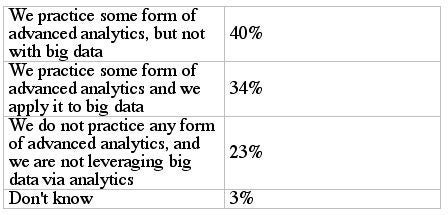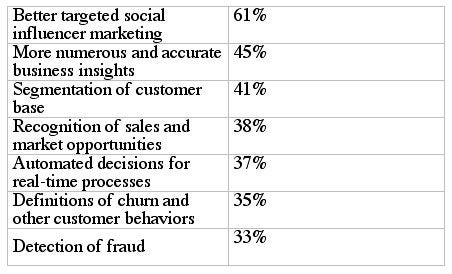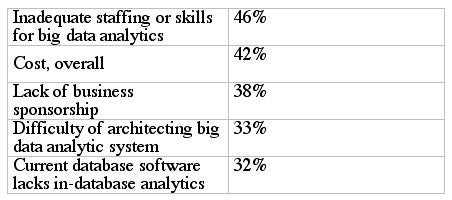Datamation content and product recommendations are
editorially independent. We may make money when you click on links
to our partners.
Learn More
In case you were wondering if everyone else was stunned by the rapid rise of big data as a normal topic of business and IT conversations, the fast answer is yes. I, too, was surprised how last year’s buzzword du jour became Standard Operating Procedure for so many companies in so short a time.
A survey a few months ago by The Data Warehousing Institute (TDWI) and a report by its research director, Philip Russom, paints a picture of a nascent trend going mainstream faster than you could say “Siri combines artificial intelligence and a search engine.”
More than 90% of the 325 IT professionals and business sponsors/users responding to the survey said they are familiar with the concept of big data analytics. Big data analytics is the term to describe subjecting many terabytes of structured and unstructured data to near real-time analysis by advanced software tools using sophisticated algorithms to find patterns and therefore opportunities.
Big data analytics is a lot bigger and more complicated than your father’s data mining. It’s been more than a decade since data mining, data clustering, market basket analyses and other related Business Intelligence/analytics tasks developed into narrow niche fields known to a relative handful of practitioners. Contrast that to the one third of the survey respondents who said they are actually engaged in big data analytics (see table):

Source: TDWI
It isn’t quite as dramatic as a perfect storm of good things happening, but a confluence of technologies are enabling organizations to actually use those terabytes of emails, blogs, tweets, videos and other information outside of a database.
“User organizations have been collecting Web data for years,” noted Russom. “For most organizations, it’s been a kind of hoarding. We’ve seen similar untapped big data collected and hoarded, such as RFID data from supply chain applications, text data from call center applications, semistructured data from various business-to-business processes, and geospatial data in logistics.”
What’s changed, Russom explained, is that “far more users are now analyzing big data instead of merely hoarding it.” And thanks to data warehouse appliances and software capable of processing the huge data flows, organizations can now find, polish and use the gems buried in the flow of jetsam swirling around their data centers.
Of course, those gems are typically the insights that many users and all the business intelligence vendors touted for their products. Better business decisions, the ability to identify disaffected customers ready to bolt (known as churn in the telecom industry), and pricing optimization by the airlines and other industries were typical of the benefits that accrued to those organizations spending big bucks for the systems.
Interestingly, the TDWI survey found those types of jewels weren’t at the top of their big data analytics expectations. Instead, it appears that big data analytics in many cases will be applied to a new challenge, social media analysis.
As you can see in the following table, the expected beneficiaries of a big data analytics initiative is a combination of what has been promised in the past as well as dealing with the current tweet, blog and YouTube challenge of today:
When asked, “which of the following benefits would ensue if organization implemented some form of big data analytics (pick no more than 5)?” here are the survey respondents’ answers:

Source: TDWI
All of these benefits are predicated on being able to implement a big data analytics program, and there’s a significant challenge. Specifically, a shortage of qualified big data people.
Currently the hot title/job description is data scientist. Even Fortune magazine’s web site recently posted articles about the huge spread between data scientist supply and demand.
The shortage of data scientists is the number one barrier to organizations jumping on the big data analytics bandwagon, according to survey respondents (see table). Note that the people shortage is an even bigger deal than the cost of the machines and software involved.
What are the top potential barriers to implementing big data analytics?

Source: TDWI
It is important to note that the skills and dollars shortage are not considered deal breakers for most companies. Only 30% of the survey respondents considered big data analytics a problem for the organization—70% considered it an opportunity.
That’s probably the most refreshing and pleasant surprise about the survey—IT is embracing the big data analytics challenge rather than trying to avoid it.
-
Huawei’s AI Update: Things Are Moving Faster Than We Think
FEATURE | By Rob Enderle,
December 04, 2020
-
Keeping Machine Learning Algorithms Honest in the ‘Ethics-First’ Era
ARTIFICIAL INTELLIGENCE | By Guest Author,
November 18, 2020
-
Key Trends in Chatbots and RPA
FEATURE | By Guest Author,
November 10, 2020
-
Top 10 AIOps Companies
FEATURE | By Samuel Greengard,
November 05, 2020
-
What is Text Analysis?
ARTIFICIAL INTELLIGENCE | By Guest Author,
November 02, 2020
-
How Intel’s Work With Autonomous Cars Could Redefine General Purpose AI
ARTIFICIAL INTELLIGENCE | By Rob Enderle,
October 29, 2020
-
Dell Technologies World: Weaving Together Human And Machine Interaction For AI And Robotics
ARTIFICIAL INTELLIGENCE | By Rob Enderle,
October 23, 2020
-
The Super Moderator, or How IBM Project Debater Could Save Social Media
FEATURE | By Rob Enderle,
October 16, 2020
-
Top 10 Chatbot Platforms
FEATURE | By Cynthia Harvey,
October 07, 2020
-
Finding a Career Path in AI
ARTIFICIAL INTELLIGENCE | By Guest Author,
October 05, 2020
-
CIOs Discuss the Promise of AI and Data Science
FEATURE | By Guest Author,
September 25, 2020
-
Microsoft Is Building An AI Product That Could Predict The Future
FEATURE | By Rob Enderle,
September 25, 2020
-
Top 10 Machine Learning Companies 2020
FEATURE | By Cynthia Harvey,
September 22, 2020
-
NVIDIA and ARM: Massively Changing The AI Landscape
ARTIFICIAL INTELLIGENCE | By Rob Enderle,
September 18, 2020
-
Continuous Intelligence: Expert Discussion [Video and Podcast]
ARTIFICIAL INTELLIGENCE | By James Maguire,
September 14, 2020
-
Artificial Intelligence: Governance and Ethics [Video]
ARTIFICIAL INTELLIGENCE | By James Maguire,
September 13, 2020
-
IBM Watson At The US Open: Showcasing The Power Of A Mature Enterprise-Class AI
FEATURE | By Rob Enderle,
September 11, 2020
-
Artificial Intelligence: Perception vs. Reality
FEATURE | By James Maguire,
September 09, 2020
-
Anticipating The Coming Wave Of AI Enhanced PCs
FEATURE | By Rob Enderle,
September 05, 2020
-
The Critical Nature Of IBM’s NLP (Natural Language Processing) Effort
ARTIFICIAL INTELLIGENCE | By Rob Enderle,
August 14, 2020
SEE ALL
DATA CENTER ARTICLES










